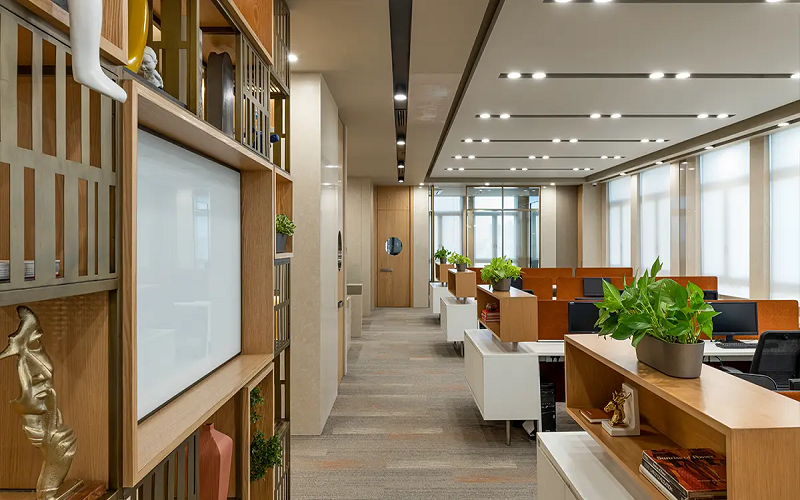How to Utilize Commercial Interior Decor to Enhance Office Spaces
The interior decor of an office space greatly impacts employee satisfaction, productivity, and company culture. Whether designing a new office or enhancing an existing one, careful consideration of interior decor elements can optimize the functionality and aesthetics of the space. From colors and lighting to layouts and furnishings, commercial interior decor provides endless opportunities to create an inviting, branded, and productive office environment. This article will explore tips on strategically utilizing commercial interior decor in uaeto enhance office spaces.
Choose a Cohesive Color Palette

One of the most impactful interior decor elements is the color palette. When planning office spaces, select 2–4 complementary colors that align with your brand identity. Neutral tones like white, beige, or gray make ideal base colors as they open up the space and allow accent colors to pop. Incorporate brand colors into accent walls, furnishings, and decor pieces. For example, a tech company could use sleek gray desks and white walls paired with their bright blue brand color on chairs and artwork.
Additionally, consider how different colors impact moods and focus. Warm tones like reds, oranges, and yellows energize, while cool blues and greens create a calming effect. Neutral earth tones promote concentration. Select colors that elicit the desired energies and brand identity you aim to achieve. A cohesive color scheme tied to branding sets the aesthetic tone for the entire office space.
Optimize lighting conditions.
Lighting significantly impacts comfort, focus, and functionality. Natural lighting is ideal as it reduces eyestrain and boosts moods. If natural light isn’t possible, choose full-spectrum bulbs to mimic daylight. Layer ambient, task, and accent lighting. Ambient light, like recessed ceiling lighting, illuminates the entire space. Task lighting, like desk lamps, enables focused work. Accent lighting on artwork or architectural details adds visual interest.
Provide lighting controls like dimmers and smart bulbs to enable workers to adjust lighting. Position desks near windows and use glass partition walls to maximize sunlight. North-facing windows prevent glare. Strategic lighting design enhances visual comfort, focus, and interior appeal.
Zone the Floor Plan
A well-planned layout complete with defined zones optimizes workflow and collaboration. Zoning based on public spaces, quiet zones, and collaboration areas prevents clutter and clearly defines the purposes for each area. Place employee desks and phones away from entrances, breakrooms, and conference rooms to reduce noise.
Create spacious pathways between zones, and use glass walls or partitions to separate spaces while maintaining an open feel. Utilize creative office layouts like benching desks, shared tables, standing desks, and modular furniture. Seek layouts that maximize natural light and ergonomics for all employees. Clearly zoning a layout into functional spaces keeps interiors organized and multi-purpose.
Curate inspiring break areas.
The decor you choose for breakrooms or lounges directly impacts employee morale and creativity. Make small kitchen areas inviting with wood floors, accent walls, cafe lighting, and greenery. Add a refreshment bar with coffee, drinks, and snacks to fuel staff.
Designate recreation nooks with cozy seating, books, games, and devices to spark creativity on breaks. Let employees showcase artwork by adding personalized decor. A well-decorated and comfortable breakroom provides a welcoming respite and mental reset throughout busy workdays.
Display engaging artwork
From graphic prints to abstract paintings, artwork adds visual interest to blank walls and spaces. When sourcing commercial art, look for unique statement pieces aligned with your brand identity and work culture. Canvases and prints from emerging local artists make great additions. Display artwork thematically by department or project type to reinforce company focus areas through decor.
Add wall decals of motivational quotes for inspiration. Rotate pieces seasonally to keep the art fresh and engaging. Defining the brand through displayed artwork stimulates minds and sparks creative conversations.
Furnish for Comfort and Function
Every piece of furniture, from chairs to cabinets, used in commercial interiors can optimize comfort or functionality. Select ergonomic task chairs that provide lumbar support during long hours. Standing desks encourage movement and alternatives to sitting. Informal modular seating promotes collaboration in lounges. Display shelving and storage cabinets maintain organization.
Choose furnishings in your brand colors and materials, like wood, leather, or plastic, that align with your style. Outfit conference rooms with tech-friendly furnishings optimized for presentations. Decorating with purposeful, branded furnishings designed for user needs balances style with function.
Add greenery for freshness.
Bringing nature indoors with plants enhances air quality and boosts mental wellbeing. Strategically place small trees or vertically staggered wall plants to liven up office interiors. Add potted plants on desks, in waiting areas, and near windows and lighting. Choose low-maintenance plants or offer plant care as an employee perk. Greenery soothes minds, adds healthy aesthetics, and improves indoor air at offices.
Showcase Brand Through Reception Areas
The reception area provides the first impression upon entering an office space. Use interior decor details to convey brand identity from the moment someone steps inside. Display logo signage and framed brand images or iconography. Incorporate branded colors into furniture like couches, rugs, and lamps. Set out coffee table books showcasing company culture, achievements, or products. Wall art, lighting fixtures, and greenery can also reinforce branding aesthetics. A thoughtfully decorated reception area sets the tone and immerses visitors in your brand story.
Define Spaces with Rugs
Area rugs help delineate and define spaces within open office floor plans. Use large printed or patterned rugs to designate lounge spaces or quiet zones. Place smaller rugs under meeting tables to define gathering areas. Incorporate accent rugs at entrances and hallways between key zones. Choose materials and patterns that dampen noise. Rugs featuring your brand colors and motifs bring unity by repeating design themes throughout the office. Defining specific zones for certain activities or moods brings clarity to the interior.
Conclusion
From colors and layouts to furnishings and artwork, office environments should be strategically designed for optimal function and representative branding. When planning commercial interior design office spaces for your next office space, keep branding, comfort, productivity, collaboration, and creativity top of mind. Thoughtfully decorating even small elements like breakrooms or lighting can profoundly enhance satisfaction, focus, and morale. By artfully weaving together purpose-driven decor elements, companies can create productive, inviting, and brand-led interiors that elevate the office experience. Thoughtful commercial interior decor ultimately enables businesses to thrive by supporting company culture, employee needs, and branding goals through intentional, inspiring design.













